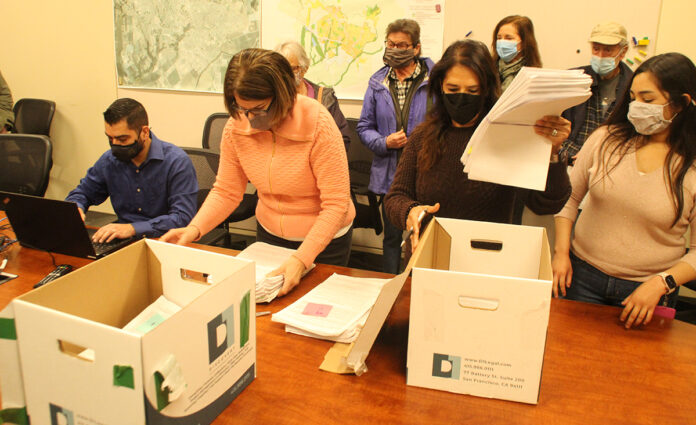A weekly guide to what’s happening.
ARTS AND MUSIC
CELTIC TEEN BAND PROGRAM Teenage musicians ages 12-19 play in an ensemble, developing musicianship, flexibility, and musical creativity. Participants work on music from Ireland, Scotland, Brittany, Norway, Sweden and the United States, in addition to modern and more quirky pieces. Instruments welcomed include fiddle, viola, flute, tin whistle, pipes, cello, upright bass, guitar, mandolin, banjo, dulcimer, autoharp, ukulele, Celtic harp, accordion and percussion. Students must have at least two years of experience on their instrument and must be able to read sheet music and chord symbols. The group meets twice a month Wednesday afternoons from 3:30-5pm at the London Nelson Center with fiddle teacher John Weed. Cost is free-$10 per session on a sliding scale. Potential students are welcome to come for a session and see if they like it—no obligation! More information and registration at CommunityMusicSchool.org/teenband. Wednesday, Dec. 15, 3:30pm. London Nelson Community Center, 301 Center St., Santa Cruz.
LET’S TALK ABOUT THE MOVIES Film buffs are invited to join us online every Wednesday night at 7pm to discuss a currently streaming movie. For more info, please visit our webpage: https://groups.google.com/group/LTATM.
NUTCRACKER PERFORMANCE Join us for our annual Santa Cruz Nutcracker performance! Featuring dancers from all ages and backgrounds, we’ve come together to offer you this spectacular show. Many members of our beloved staff, including Studio Director Shannon Chipman and ballet teacher Vicki Bergland, performed in the original Santa Cruz Nutcracker Production. Even more, they continue to dance and teach to this day. Invite in the holiday spirit and come enjoy Tchaikovsky’s iconic score with our talented dancers, right in Cabrillo’s Crocker Theater. Friday, Dec. 17, 10am. Saturday, Dec. 18, 10am. Sunday, Dec. 19, 10am. Cabrillo Crocker Theater, 6500 Soquel Drive, Aptos.
THE SANTA CRUZ CHORALE PRESENTS CHRISTMAS WITH THE CHORALE We are happy to let you know that, in spite of Covid-19, we are planning to have our “Christmas with the Chorale” concerts—of course with a few changes to ensure safety. The choir members are all vaccinated, we’ll be singing with masks, and the audience must also be masked and vaccinated. In addition, the concert will be shorter than usual, with no intermission, and since the size of the audience will be smaller than can fill Holy Cross, you’ll have to order your tickets early! But even with these limitations that are unpleasant for all of us, you can be sure, there will be no limitations to the beauty of the program! Beginning with what is some of the oldest known Christmas music, Gregorian chant, we will sing music from centuries past, and right up to compositions from modern times. We will again be joined by the Monterey Bay Sinfonietta, and of course we will also perform favorite carols from around the world. We are very much looking forward to finally seeing you again, and to sharing with you the joy of Christmas music. Saturday, Dec. 18, 8pm. Sunday, Dec. 19, 4pm. Holy Cross Church, 210 High St., Santa Cruz.
TOMÁSEEN FOLEY’S A CELTIC CHRISTMAS For the 26th season, Tomáseen Foley’s A Celtic Christmas brings traditional Irish musicians and dancers to enthralled audiences across the country. At its center is native Irish storyteller, Tomáseen Foley. A Celtic Christmas springs from the infinitely rich treasury of Ireland’s cultural heritage: a re-creation of a night before Christmas in the West of Ireland in the 1940s, before the advent of the motorcar, the television, and the telephone. In this recreation of age-old tradition, neighbors bring their fiddles, tin whistles, flutes, bodhráns, uilleann pipes; and, perhaps most important of all, their unshakeable sense of community, for a night of traditional music, song, dance and of course storytelling. The show’s music director is a Grammy Award-winning guitarist and Santa Cruz resident William Coulter, an internationally recognized master of the steel-string guitar. Friday, Dec. 17, 7:30pm. Rio Theatre, 1205 Soquel Ave., Santa Cruz.
WHEN WE PAINT OUR MASTERPIECE: THE ART OF THE GRATEFUL DEAD COMMUNITY Learn how the members of the Grateful Dead and the global Deadhead community took inspiration from one another in creating an image-rich, worldwide art practice that, like the band’s music, scrambled perceived standards and norms. The creative works presented in When We Paint Our Masterpiece reveal a world full of variety when it comes to design practices, international traditions, visual icons, and vernacular art forms. There has been space for all of these patterns and visions in the community of fans and fellow artists that blossomed around the band, and that community of creators continues to thrive today. This exhibit explores the mutual appreciation among fans as well as between fans and the band. Free. McHenry Library, UCSC, 1156 High St., Santa Cruz. Through December 22, 2022.
COMMUNITY
ADVANCE DIRECTIVE INDIVIDUAL SESSIONS WATSONVILLE Our individual sessions are perfect for people who are ready to complete their Advance Directives, with support. Schedule a one-on-one appointment to complete your Advance Directive. We will share copies of the necessary forms and walk you through filling them out, step by step. To make an appointment, please call 831-430-3000 and ask for Vanessa Silverstein. Wednesday, Dec. 15, 10am-1pm. Hospice of Santa Cruz County, 65 Nielson St., Watsonville.
COMMUNITY DRUMMING WITH JIM GREINER IN PERSON Percussionist/Educator Jim Greiner will conduct the next in his monthly third Friday series of community drumming sessions at the Inner Light Center in Soquel in person from 7-8:30pm. Doors open at 6:45pm. The cost is $10. Masks and social distancing requirements will be honored. Jim makes it fun and easy for people from all walks of life to play drums and hand percussion to release stress, to uplift and energize yourself, and to reinforce positive life rhythms through percussion playing. Friday, Dec. 17, 7-8:30pm. Inner Light Center, 5630 Soquel Drive, Soquel.
COMMUNITY PILATES MAT CLASS Come build strength with us. This very popular in-person community Pilates Mat Class in the big auditorium at Temple Beth El in Aptos is in session once again. Please bring your own mat, small Pilates ball and theraband if you have one. You must be vaccinated for this indoor class. Suggested donation of $10/class. Thursday, Dec. 16, 10am. Tuesday, Dec. 21, 10am. Temple Beth El, 3055 Porter Gulch Road, Aptos.
CUÉNTAME UN CUENTO Acompáñanos para una hora de cuentos, actividades y canciones en español. Este programa es para niños de 0-8 y sus familias. La hora será miércoles a las 4:30pm. Nos reuniremos en el porche exterior. Cuéntame un Cuento se llevará a cabo en Capitola durante el período de construcción de Live Oak. En caso de mal clima, se cancelará la hora de cuentos. Join us for Spanish Storytime, activities, and music! This program is best suited for kids ages 0-8 and their families. Storytime takes place on Wednesday at 4:30pm. We will meet on the outside porch. Storytime will take place at Capitola during Live Oak’s construction period. In the event of bad weather, storytime will be cancelled. Wednesday, Dec. 15, 4:30pm. Capitola Library A Santa Cruz City County Public Library Branch, 2005 Wharf Road, Capitola.
DOWNTOWN SANTA CRUZ MAKERS MARKET Come on out and support local makers and artists at the Downtown Santa Cruz Makers Market every third Sunday of the month on Pacific Ave at Lincoln St. We are now on the 1100 block of Pacific Ave. between Cathcart St. and Lincoln St. near New Leaf and alongside so many amazing downtown restaurants. Support local and shop small with over 30 Santa Cruz County artists and makers! Don’t forget to stop in and visit the downtown merchants and grab a bite to eat from the downtown restaurants. Remember to social distance as you shop and wear your mask. If you’re not feeling well, please stay home. There will be hand sanitizing stations at the market and signs to remind you about all these things! Friendly leashed pups are welcome at this free event! Sunday, Dec. 19, 10am-5pm. Downtown Santa Cruz Makers Market, Pacific Ave., Santa Cruz.
FARLEY’S CHRISTMAS WONDERLAND From Saturday, November 27 to Friday, December 31 (except when it’s raining), Farley’s Christmas Wonderland will be open. A walk-in Christmas display located in the midtown of Santa Cruz, this exhibit is very traditional: lots of Christmas trees, garlands, sleighs, an elf village, a miniature village, and a log cabin that Santa uses for his rest stops. There is also a fairy grotto with two waterfalls and fairies that can be viewed on special nights. Also, on those special nights, it even snows! Donations are welcome. 108 Seaview Ave., Santa Cruz. farleys-christmas-wonderland.com.
GREY BEARS BROWN BAG LINE Grey Bears are looking for help with their brown bag production line on Thursday and Friday mornings. Volunteers will receive breakfast and a bag of food if wanted. Be at the warehouse with a mask and gloves at 7am. Call ahead for more information: 831-479-1055, greybears.org. Thursday, Dec. 16, 7am. California Grey Bears, 2710 Chanticleer Ave., Santa Cruz.
HOLIDAY LIGHTS TRAIN A seasonal tradition returns to Santa Cruz with the Santa Cruz Holiday Lights Train. Vintage excursion cars, adorned with thousands of colorful lights, roll through city streets past homes of Santa Cruz. First-class private coach cars can also be reserved for groups up to 50 people. Availability is limited so book in advance. Roaring Camp Railroads, 5401 Graham Hill Road, Felton. Runs through Dec. 23. Schedule and tickets at roaringcamp.com.
HOLIDAY LIGHTS 2021 The Santa Cruz County Fairgrounds Foundation and the Agricultural History Project presents Holiday Lights 2021 at the Santa Cruz County Fairgrounds. Holiday Lights is a half-mile drive-through experience at the fairgrounds of spectacular lighted holiday displays. See giant Christmas trees twinkling with lights, Santa, reindeer, snowmen, lighted tunnels and more. New this year are two evenings of walk-through holiday lights on Friday, Dec. 3 and Saturday, Dec. 4 in conjunction with the Heritage Holiday Craft and Gift Fair. Tickets will only be available at the gate for these two evenings, and ticket gets you admission to Holiday Fair Shopping, too. For drive-through tickets (Thursday, Friday, Sunday), go eventbrite.com/e/holiday-lights-tickets.
KNITTING AT THE FELTON LIBRARY Join us every Monday afternoon at the Felton Branch for a knitting party. All you need to do is bring some yarn and knitting needles. All ages are welcome. Monday, Dec. 20, 12:30pm. Felton Branch Library, 6121 Gushee St., Felton.
TOY TRAINS 2021 Get whisked away into the whimsical world of toy trains and enjoy the 16th year of this beloved annual pop-up exhibit at the Museum of Art & History (MAH). Members of the Golden State Toy Train Operators will be on hand to once again share their amazing collection of toy trains at the MAH. First things first, we encourage you to be and stay safe. We are still living during a pandemic. Masks required when viewing the train display. 12-6pm Thursday, December 16-Sunday, Dec. 19. Santa Cruz Museum of Art and History, 705 Front St., Santa Cruz.
WINTER FAMILY DAY 2021 Enjoy free admission to all our current exhibitions, plus the Toy Trains display in the Atrium all day! Drop in from 2-4pm to make a button and create seeds of growth to welcome in the new year. Sunday, Dec. 19. Santa Cruz Museum of Art and History, 705 Front St., Santa Cruz.
GROUPS
ENTRE NOSOTRAS GRUPO DE APOYO Entre Nosotras support group for Spanish speaking women with a cancer diagnosis. Meets twice monthly. Registration required, please call Entre Nosotras 831-761-3973. Friday, Dec. 17, 6pm. WomenCARE, 2901 Park Ave., Suite A1, Soquel.
S+LAA MENS’ MEETING Having trouble with compulsive sexual or emotional behavior? Recovery is possible. Our small 12-step group meets Saturday evenings. Enter through the front entrance, go straight down the hallway to the last door on the right. Thursday, Dec. 16, 6pm. Sutter Maternity & Surgery Center, 2900 Chanticleer Ave., Santa Cruz.
WOMENCARE ARM-IN-ARM WomenCARE Arm-in-Arm Cancer support group for women with advanced, recurrent, or metastatic cancer. Meets every Monday, currently on Zoom. Registration is required, call WomenCARE at 831-457-2273. All services are free. For more information visit womencaresantacruz.org. Monday, Dec. 20, 12:30pm.
WOMENCARE MINDFULNESS MEDITATION Mindfulness meditation for women with a cancer diagnosis. Meets the 1st and 3rd Friday, currently on Zoom. Registration required please call WomenCARE 831-457-2273. Friday, Dec. 17, 11am-noon.
WOMENCARE TUESDAY SUPPORT GROUP WomenCARE Tuesday Cancer support group for women newly diagnosed and through their treatment. Meets every Tuesday currently on Zoom. Registration required, call WomenCARE 831-457-2273. Tuesday, Dec. 21, 12:30-2pm.
WOMENCARE: LAUGHTER YOGA Laughter yoga for women with a cancer diagnosis. Meets every Wednesday, currently via Zoom. Registration is required, please call WomenCARE at 831-457-2273. Wednesday, Dec. 15, 3:30-4:30pm.
OUTDOOR
HISTORIC RANCH GROUND TOUR Discover what life was like a century ago on this innovative dairy ranch. This hour-long tour includes the 1896 water-powered machine shop, barns and other historic buildings. The vehicle day-use fee is $10. For more information, call 831-426-0505. Spaces are limited and early pre-registration is recommended. Attendees are required to self-screen for Covid-19 symptoms when pre-registering. Masks and social distancing are also required at all programs. Saturday, Dec. 18, 1-2pm. Sunday, Dec. 19, 1-2pm. Wilder Ranch State Park, 1401 Coast Road, Santa Cruz.
























